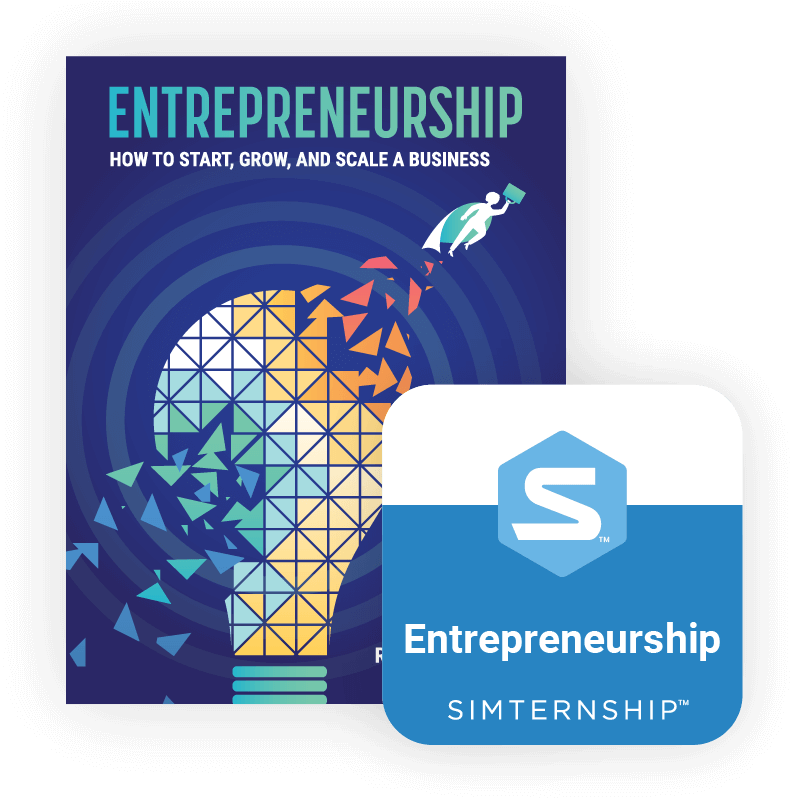The Business Research Essentials Bundle
The Business Research Essentials courseware and Simternship provide a cohesive teaching experience for educators and a cohesive learning experience for students.
Combining the courseware and simulation helps students:
- Develop Real-world Skills
- Grasp research concepts and methods
- Learn through hands-on Experience
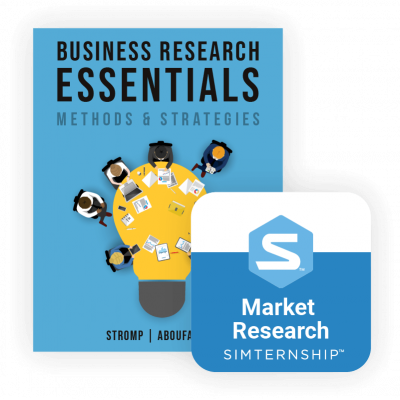
Business Research Essentials Courseware
Business Research Essentials Courseware
The Guide for Future Business Leaders
Stukent’s “Business Research Essentials” courseware educates budding business leaders to identify a problem they want to solve. It teaches them how to effectively learn more about the problem and decipher the data gained from their research efforts. Then it allows them to use the insights gained to improve an aspect of their business.
The courseware uses the primary metrics most companies monitor via a balanced scorecard as its framework. It illustrates how to use best practices to research these areas when they are underperforming. To that end, the courseware is organized by first introducing research methods. Then it segues into how managers and business leaders can apply those research methods to the balanced scorecard perspectives (financial, customer, internal process, learning, and growth) and to business functions outside the balanced scorecard perspectives (product and marketing research).
The materials available provide you with the resources to teach an authoritative course in less prep time.
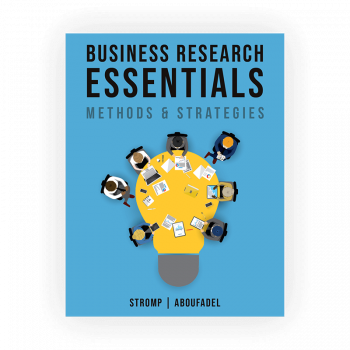
Table of Contents
Introduction to Research Concepts and Methods
Chapter 1: Introduction to Business Research
Chapter 2: Business Intelligence
Chapter 3: Qualitative Primary Research
Chapter 4: Survey Research
Chapter 5: Data Analysis
Chapter 6: Data Visualization and Reporting
Applying Research Concepts and Methods to the 4 Balanced Scorecard Perspectives
Chapter 7: Financial Perspective
Chapter 8: Customer Perspective
Chapter 9: Internal Process Perspective
Chapter 10: Learning and Growth Perspective
Applying Research Concepts and Methods to Market Research
Chapter 11: Product Research
Chapter 12: Marketing Research
Key Learning Objectives
Chapter 1: Introduction to Business Research
- Define key research ideas, including:
- The research question
- Quantitative and qualitative research
- Business intelligence
- Primary research
- Key performance indicators (KPIs)
- Determine when and why to conduct business research.
- Map the different types of business research questions to the balanced scorecard framework.
Chapter 2: Business Intelligence
- Define internal business intelligence and associated tools, including operational data systems, data warehouses, and internal secondary data.
- Describe the steps for using internal business data.
- Explain the applications for external business intelligence as well as its advantages and limitations.
- Describe secondary research and its uses within business intelligence (both internal and external).
- Carry out environmental scanning and relate its uses to strategic planning.
Chapter 3: Quality Primary Research
- Identify qualitative primary research methods.
- Determine when to use the following qualitative primary research methods: focus groups, ethnographic business research, and mystery shopping.
- Develop best practices related to the following qualitative primary research methods: focus groups, ethnographic business research, and mystery shopping.
Chapter 4: Survey Research
- Determine when to use and how to properly design business research surveys.
- Articulate the use of common survey components.
- Create surveys that employ best practices in survey development.
- Identify and avoid common survey development mistakes.
Chapter 5: Data Analysis
- Prepare raw data for data analysis.
- Identify and run appropriate descriptive statistics for data summaries.
- Demonstrate the value of cross-tabulations when examining market segments.
- Determine correct inferential statistical tests.
Chapter 6: Data Visualization and Reporting
- Use data to develop conclusions and recommendations.
- Demonstrate proper data visualization choices.
- Incorporate report components according to best practices.
Chapter 7: Financial Perspective
- Identify research questions related to the financial perspective of an organization.
- Express the ways sales data are disaggregated.
- Delineate techniques used in sales forecasting.
- Use regression analysis to identify factors that most predict sales.
- Calculate and use market share estimates.
Chapter 8: Customer Persective
- Articulate common customer perspective research objectives and questions.
- Use internal and external business intelligence in order to understand customers.
- Employ customer segmentation techniques.
- Develop customer satisfaction surveys.
- Utilize focus group methodology to uncover underlying issues impacting customer satisfaction.
Chapter 9: Internal Process Perspective
- Describe key performance indicators that are related to the balanced scorecard internal process perspective.
- Identify internal and external (benchmarking) data sources needed to examine process issues.
- Develop and interpret primary research related to aiding process improvement, including employee surveys and focus groups, observational research, and mystery shopping.
Chapter 10: Learning and Growth Perspective
- Describe key performance indicators that are related to the Balanced Scorecard learning and growth perspective.
- Develop and interpret primary research related to aiding employee satisfaction, employee capability, or workplace climate.
- Apply segmentation and trend data to provide further insight into measures of learning and growth.
Chapter 11: Product Research
- Determine when to apply and how to construct the common research tools related to product research: secondary, focus groups, surveys, and ethnographic.
- Incorporate the competitive landscape, consumer trends, industry trends, pricing, and brand acceptance topics into product research data collection.
- Analyze product research results with a focus on providing strategic recommendations.
Chapter 12: Marketing Research
- Develop and interpret brand research for an organization using best practices.
- Deploy and analyze advertising concept tests that incorporate common key measures, such as favorability, uniqueness, and fit.
- Conduct secondary competitive marketing research
- Describe the types of digital marketing data gathered and how it is used for strategy .
- Incorporate segmentation in strategic decision-making regarding communication with sub-markets.
Educator Resources
The courseware’s materials make teaching business research easier for you and more engaging for students. The following resources are included:
Auto-graded quiz for each chapter
36 turnkey assignments
4 case studies
Comprehensive project
Lesson plans for each chapter
Real-world examples
Sample syllabus and course calendars
Cumulative glossary for student reference
LMS integration with Stukent platforms
Introduction to Research Concepts and Methods
Chapter 1: Introduction to Business Research
Chapter 2: Business Intelligence
Chapter 3: Qualitative Primary Research
Chapter 4: Survey Research
Chapter 5: Data Analysis
Chapter 6: Data Visualization and Reporting
Applying Research Concepts and Methods to the 4 Balanced Scorecard Perspectives
Chapter 7: Financial Perspective
Chapter 8: Customer Perspective
Chapter 9: Internal Process Perspective
Chapter 10: Learning and Growth Perspective
Applying Research Concepts and Methods to Market Research
Chapter 11: Product Research
Chapter 12: Marketing Research
Chapter 1: Introduction to Business Research
- Define key research ideas, including:
- The research question
- Quantitative and qualitative research
- Business intelligence
- Primary research
- Key performance indicators (KPIs)
- Determine when and why to conduct business research.
- Map the different types of business research questions to the balanced scorecard framework.
Chapter 2: Business Intelligence
- Define internal business intelligence and associated tools, including operational data systems, data warehouses, and internal secondary data.
- Describe the steps for using internal business data.
- Explain the applications for external business intelligence as well as its advantages and limitations.
- Describe secondary research and its uses within business intelligence (both internal and external).
- Carry out environmental scanning and relate its uses to strategic planning.
Chapter 3: Quality Primary Research
- Identify qualitative primary research methods.
- Determine when to use the following qualitative primary research methods: focus groups, ethnographic business research, and mystery shopping.
- Develop best practices related to the following qualitative primary research methods: focus groups, ethnographic business research, and mystery shopping.
Chapter 4: Survey Research
- Determine when to use and how to properly design business research surveys.
- Articulate the use of common survey components.
- Create surveys that employ best practices in survey development.
- Identify and avoid common survey development mistakes.
Chapter 5: Data Analysis
- Prepare raw data for data analysis.
- Identify and run appropriate descriptive statistics for data summaries.
- Demonstrate the value of cross-tabulations when examining market segments.
- Determine correct inferential statistical tests.
Chapter 6: Data Visualization and Reporting
- Use data to develop conclusions and recommendations.
- Demonstrate proper data visualization choices.
- Incorporate report components according to best practices.
Chapter 7: Financial Perspective
- Identify research questions related to the financial perspective of an organization.
- Express the ways sales data are disaggregated.
- Delineate techniques used in sales forecasting.
- Use regression analysis to identify factors that most predict sales.
- Calculate and use market share estimates.
Chapter 8: Customer Persective
- Articulate common customer perspective research objectives and questions.
- Use internal and external business intelligence in order to understand customers.
- Employ customer segmentation techniques.
- Develop customer satisfaction surveys.
- Utilize focus group methodology to uncover underlying issues impacting customer satisfaction.
Chapter 9: Internal Process Perspective
- Describe key performance indicators that are related to the balanced scorecard internal process perspective.
- Identify internal and external (benchmarking) data sources needed to examine process issues.
- Develop and interpret primary research related to aiding process improvement, including employee surveys and focus groups, observational research, and mystery shopping.
Chapter 10: Learning and Growth Perspective
- Describe key performance indicators that are related to the Balanced Scorecard learning and growth perspective.
- Develop and interpret primary research related to aiding employee satisfaction, employee capability, or workplace climate.
- Apply segmentation and trend data to provide further insight into measures of learning and growth.
Chapter 11: Product Research
- Determine when to apply and how to construct the common research tools related to product research: secondary, focus groups, surveys, and ethnographic.
- Incorporate the competitive landscape, consumer trends, industry trends, pricing, and brand acceptance topics into product research data collection.
- Analyze product research results with a focus on providing strategic recommendations.
Chapter 12: Marketing Research
- Develop and interpret brand research for an organization using best practices.
- Deploy and analyze advertising concept tests that incorporate common key measures, such as favorability, uniqueness, and fit.
- Conduct secondary competitive marketing research
- Describe the types of digital marketing data gathered and how it is used for strategy .
- Incorporate segmentation in strategic decision-making regarding communication with sub-markets.
The courseware’s materials make teaching business research easier for you and more engaging for students. The following resources are included:
Auto-graded quiz for each chapter
36 turnkey assignments
4 case studies
Comprehensive project
Lesson plans for each chapter
Real-world examples
Sample syllabus and course calendars
Cumulative glossary for student reference
LMS integration with Stukent platforms
The Market Research Simternship
Solidify Theory with Hand-on Practice
In the simulation, students complete a market research project from start to finish, from building surveys and moderators’ guides to creating a final report. What’s more, it’s done in a way that’s simple, digestible, and fun!
Add Real-world Skills to Your Students' Resumes
The Market Research Simternship is a game-changing simulation for market research students. Created in partnership with both educators and industry professionals, the Simternship gives students real-world skills they can add to their resumes.
Spend More Time Teaching
The Simternship is completely auto-graded, so you can spend less time preparing and grading and more time helping students build valuable skills. This unique simulation shortens the learning curve and prepares students to compete in a growing job market.
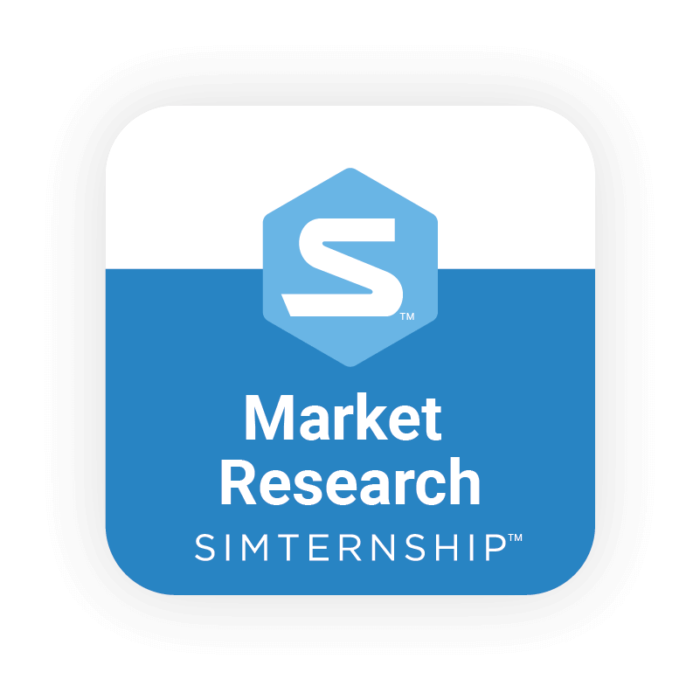
Key Learning Objectives
- Analyze requests for proposal to determine research methodologies.
- Identify key findings from secondary and primary research.
- Build moderators’ guides for focus groups.
- Create survey instruments for gathering primary data.
- Calculate sample size estimates and identify sampling techniques.
- Select a sampling plan for data collection.
- Categorize open-ended survey responses using a code list.
- Identify study limitations based on a client’s target market and demographic survey responses.
- Select visuals for quantitative and qualitative survey data.
- Evaluate cross-tabulations to identify segment differences.


Analyze a Focus Group Recording
Identify Key Findings from Research


Create Surveys
Code Open-ended Survey Responses

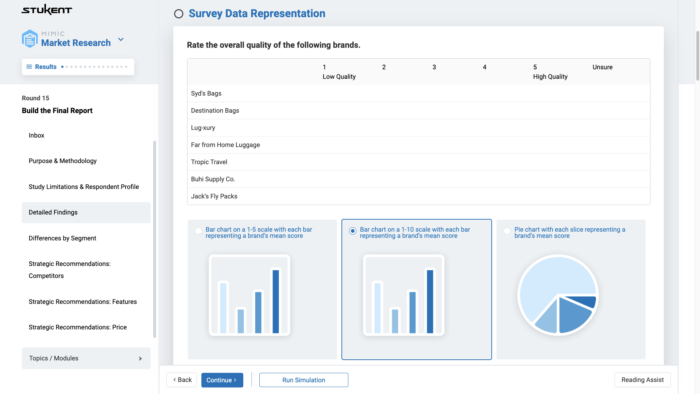
Visualize Data
Expand Your Definition of Courseware
Updated every year
with lifetime access for students
Keeping Content Current
The media and materials included with the business research methods textbook and courseware make it an in-depth teaching tool. The content is updated yearly so you can be sure you’re teaching up-to-date principles.
Stukent Support Team
with a 96% customer service satisfaction rating
Support for Students and Educators
The Stukent Support Team simplifies the learning process for students and educators. Anyone who uses Stukent courseware automatically has access to our support team to answer any courseware and technical-specific inquiries.
Hands-on Learning without the Hassle
Stukent Simternships integrate with your favorite LMS platforms
Single Sign-on
Grade Book Syncing
Deep Linking
Rostering





